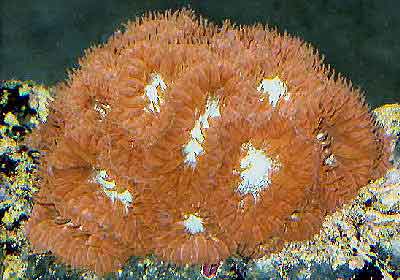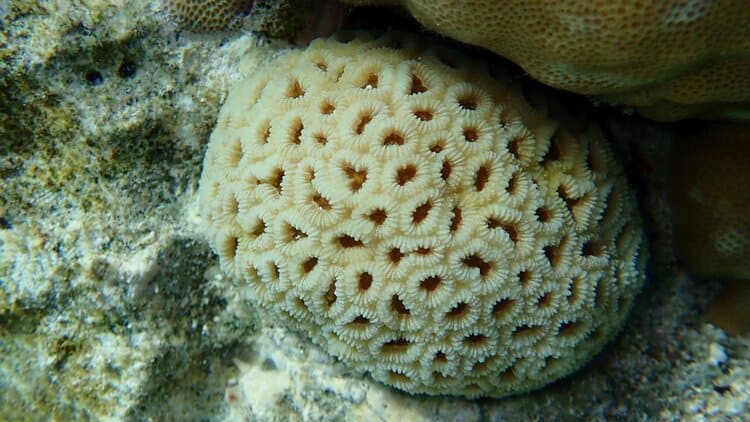
The Pineapple Coral has wonderful natural colors, and even more stunning colors in captive bred specimens!
The beautiful Pineapple Coral Blastomussa merleti is one of the two highly favored Blastomussa corals. The other is its even more colorful cousin the Blasto Coral Blastomussa wellsi. Yet of the two, the B. merleti is considered to be the easier to care for.
The colors of the Pineapple Coral are unique to this species. The centers are usually green and the outer area is brown to dark red. Exciting new aquacultured specimens come in pinks, maroons and various shades of green, with centers from yellow greens to deep greens. Some other names this coral is known for are Blastomussa Coral, Pipe Blastomussa, Branched Cup Coral, Blasto Merleti, Branching Blastomussa, Blasto Pipe, Red and Green Blastomussa, and Blasto Pineapple Coral.
The Pineapple Coral B. merleti is a great large polyp stony (LPS) coral and makes an excellent centerpiece for the aquarium. Though they are slow growers, they are easy to moderate to care for. If you forget to feed them, they could care less. They can be fed directly and that will make them grow faster, but they are also content to take nutrients from the water column. Provide moderate lighting along with moderate, turbid water movement. Strong light will prevent the polyps from opening fully and can cause it to recede. Too strong of a water flow will also cause the polyps to close, and will make it impossible to feed.
The beautiful Blastomussa Corals are rather unique. They start out in colonies with each corallite extending out from a common center, creating a branching structure that extends upward in a ‘dome’ shape. However, over time these individual corallites can lose organic connection. Then rather than being a colony, each corallite becomes a cloned solitary individual.
When the large fleshy polyps of the Blastomussa corals are fully expanded, their underlying structure is hidden. They can then superficially resemble mushroom corals or be confused with other other brain corals as well as the Candy Cane Coral or Trumpet Coral. But when their polyps retract, it quickly becomes obvious they are Blastos.
Blastomussa corals have been rare in the industry due to their natural habitat. They are found in turbid waters on the lower reef slopes, making them rather difficult to collect. However many people have propagated these easy to grow large polyp stony (LPS) corals, so though still considered more rare, availability is much better today.
Scientific name
Family: Mussidae
Species: Blastomussa merleti
Distribution / Background
Blastomussa Coral Information: The Blastomussa genus was described by Wells in 1961. According to author Vernon in is book “Corals of Australia and the Indo-Pacific”, there are three true species. However, there are 2 species that are officially recorded at this time and they are Blastomussa merleti and Blastomussa wellsi. Some of the names they are known for are Pineapple Coral, Open Brain Coral, Moon Coral, Blastos, Blastomussa, merleti, and wellsi.
The B. merleti was described by Wells in 1961. Some common names these corals are know for are Blastomussa Coral, Pipe Blastomussa, Branched Cup Coral, Blasto Merleti, Branching Blastomussa, Blasto Pipe, Red and Green Blastomussa, and Blasto Pineapple Coral.The B. merleti has been propagated in captivity with great success.
Where Blastomussa Corals Are Found: The Blastomussa merleti is located around Australia, on the Great Barrier Reef, and south to the Houtman Islands. They are also found from Madagascar to New Caledonia.
Blastomussa Coral Habitat: The Blastomussa merleti live in turbid waters on lower reef slopes at depths from 0 – 131 feet (0 – 40 m). They feed at night, extending tentacles.
Status
The B. merleti is not on the IUCN Red List of Endangered Species.
Description
What do Blastomussa Corals look like: The skeletal structure of B. merleti starts from a common base and branches upward in a “dome” shape. It has been called the Pipe Blastomussa, and like the pipe coral there are individual polyps that make the entire coral look solid when expanded. Once the polyps contract, the obvious skeletal structure which consists of individual branches becomes apparent. These corallite stalks reach just less than 7 mm in diameter, yet the polyp itself can be 1 – 2″ (2.5 – 5 cm). All these thin, easy to break branches emanate from a common central base. Many divers have just snapped off what they need and leave the mother colony intact. Life span is unknown.
In nature the colors are unique to this species. The centers are usually green and the outer area is brown to dark red. Variations in color from propagation are pinks, maroons and various shades of green with centers from yellow greens to deep greens.
There are some easily identifiable differences between B. wellsi and B. merleti. The polyps on the Pineapple Coral B. merleti are only about half as large in diameter as those of its cousin. On B. wellsi they can reach up to 4 to 5″ (10 – 13 cm) across while on B. Merleti the polyp can reach about 1 to 2″ (2.5 – 5 cm). Both species branch, but the corallites of the Pineapple Coral B. Merleti are less than 7 mm in diameter, while the corallite branches on the Blasto Coral B. wellsi are closer together and much larger in diameter. It has asymmetrical corallites that are 9 -14 mm, while the corallites of the Pineapple Coral B. Merleti are less than 7 mm in diameter. The long tubular coralites of B. merleti are brittle and easily broken, making them easy to frag without damaging the mother colony.
Difficulty of Care
Blastomussa Coral Care: Like other Mussids, the B. merleti is is easy to moderate to care for. Provide a moderate light, as strong light will prevent the polyps from opening fully and cause it to recede. They need shade in tanks with Metal Halides, yet may possibly be slowly acclimated to MH. Water flow should be moderate and turbid as well. Strong water movement will also cause the polyps to close and will make it impossible to feed. Like other members of the Mussidae family, the polyps tentacles come out at night to feed.
Foods / Feeding
Blastomussa Coral Feeding: The Blastomussa genus, like other large polyp stony (LPS) corals, have developed several feeding strategies. Through a symbiotic relationship with a marine algae, known as zooxanthellae, they receive some of their nutrients. They also capture planktonic organisms, food particles from the water column, and can absorb dissolved organic matter.
In captivity,B. merleti does very well being fed zooplankton, mysis, cyclopeeze, and other very small minced shrimp or fish. Feeding several times a week can help them grow faster. Each polyp can be its own animal, so make sure you are feeding all the polyps.
Aquarium Care
Typical water changes of 20% a month, 10% biweekly, or 5% weekly are needed. It has been noted that 5% weekly water changes replenish many of the needed additives and it is ultimately cheaper than purchasing additives for the water. With higher concentrations of coral with calcareous skeletons though, there may be a need put in additional additives to maintain proper levels for good growth.
The following water supplements are suggested for Blastomussa species:
- Calcium: 400 to 425 ppm. If a large poly stony (LPS) coral does not have enough calcium, it will not grow. (Seachem makes a calcium additive that states 385 as sufficient)
- Alkalinity: 3.2 – 4.8 MEQ/L (8 to 11 dKh, 10 is recommended)
- Phosphates: 0, zero.
- Magnesium: 1200 – 1350. Magnesium makes calcium available, so if your calcium is low, check your magnesium levels before adding any more calcium.
- Strontium: 8 – 10
Aquarium Parameters
A well-feed live rock/reef environment is what is needed for your Blastomussa Coral, along with some fish for organic matter production, and dissolved organics. It needs to be placed among the rock work, rather than on the sand. A mature tank is recommended.
| Quick Reference Chart | |||
|---|---|---|---|
| Lighting: | |||
| Water Flow: | |||
| Temperament: | |||
Be sure to have proper water movement and lighting. Provide moderate lighting and a low to moderate water flow for the best health. Provide shade when using metal halides, since the Pineapple Coral will not fully open under lighting that is too strong. Strong water movement will also cause the polyps to close and will make it impossible to feed. This is an aggressive species, extending their sweeper tentacles at night. There needs to be plenty of space between it and other corals.
- Minimum Tank Size / Length: 29 gallon (106 L) nano reef or larger
- Marine Lighting: Low to medium, provide shade when using metal halides
- Temperature: 76° – 83° F (24° – 28° C)
- Salinity / Specific Gravity: 1.023 – 1.025
- Water Movement: Moderate and turbid
- Water Region: Bottom of the aquarium
Compatibility and Social Behaviors
The Blastomussa genus is aggressive towards other corals. The B. merleti will tolerate their same species, but they do need to be kept well away from other corals. They have tentacles that come out at night and sting nearby corals, but more than likely are the ones that will be over taken.
The the wild, the Blastomussa corals coexists with many organisms that find its skeletal structure ideal for hiding, and protection from predators. It is found with various mollusks, sponges and some sessile invertebrates.
Sex – Sexual differences
Breeding and Reproduction
The large polyp stony (LPS) corals are hermaphrodites, male and female within the same organism, and can reproduce both sexually and asexually. In the wild they reproduce sexually by releasing eggs and sperm at the same time, resulting in a fertilized egg which then forms into a free-swimming planula larva. Eventually the planula larvae settles onto the substrate, becoming plankters. This then forms a tiny polyp which begins to excrete calcium carbonate and develops into a coral. Planula larvae are extremely vulnerable to predation, and very few survive.
The Blastomussa genus are hermaphrodites that use external fertilization in the wild. This genus reproduce asexually as well, using budding to propagate itself. In captivity, the B. merleti can be propagated by fragmenting. Propagation is very easy. Taking care to have clean or gloved hands, simply use a bone cutter or strong scissors to cut off individual branches. Make sure the newly fragged polyps have a low to moderate water flow to help them heal.
Potential Problems
The B. merleti are attractive and durable when their needs are provided for. Turning brown or bleaching may be an indication that the light is to strong. Be careful to keep them free from mollusks, sponges and some sessile inverts, so the water flow between their branches is not restricted.
Availability
Blastomussa Corals for Sale: The B. merleti is very easy to find at pet shops and on line. The cost for online stores is around $30.00 USD per frag (3-4 polyps), up to over $100.00 USD for a colony depending on size and/or color.
References
- Animal-World References: Marine and Reef
- Anthony Calfo, Book of Coral Propagation, Volume 1 Edition 2: Reef Gardening for Aquarists, Reading Trees; 2nd edition, 2007
- Eric Borneman, Aquarium Corals : Selection, Husbandry, and Natural History , TFH Publications, 2001
- J.E.N. Veron, Corals of Australia and the Indo-Pacific, University of Hawaii Press; 2 Rev Ed edition, 1993
- Blane Perun, Blastomussa, Blane Perun’s TheSea.Org, copyright 2010
- Eric Borneman, Bevy of Blastomussa, Reefkeeping, an online magazine for the marine aquarist, copyright 2008
- Bob Goemans, Pineapple/Open Brain Coral, Moon Coral, or simply ÂBlastomussa’, Animal Library, Saltwatercorner.com
Featured Image Credit: Alexey Masliy, Shutterstock
